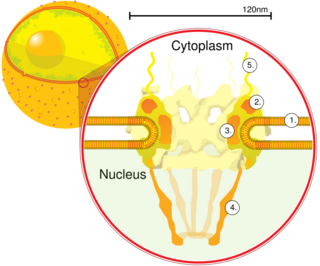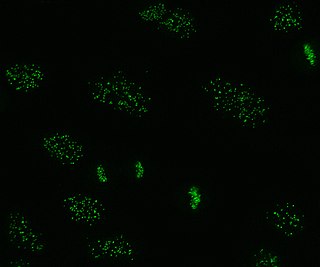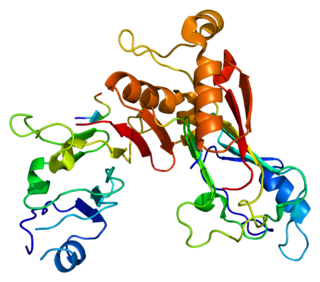
Antinuclear antibodies are autoantibodies that bind to contents of the cell nucleus. In normal individuals, the immune system produces antibodies to foreign proteins (antigens) but not to human proteins (autoantigens). In some individuals, antibodies to human antigens are produced.

Primary biliary cholangitis (PBC), previously known as primary biliary cirrhosis, is an autoimmune disease of the liver. It results from a slow, progressive destruction of the small bile ducts of the liver, causing bile and other toxins to build up in the liver, a condition called cholestasis. Further slow damage to the liver tissue can lead to scarring, fibrosis, and eventually cirrhosis.
An autoantibody is an antibody produced by the immune system that is directed against one or more of the individual's own proteins. Many autoimmune diseases are caused by such autoantibodies.

In histopathology, a Mallory body, Mallory-Denk body, and Mallory's hyaline, is an inclusion found in the cytoplasm of liver cells. Mallory bodies are damaged intermediate filaments within the hepatocytes.

Anti-mitochondrial antibodies (AMA) are autoantibodies, consisting of immunoglobulins formed against mitochondria, primarily the mitochondria in cells of the liver.

Dihydrolipoyl transacetylase is an enzyme component of the multienzyme pyruvate dehydrogenase complex. The pyruvate dehydrogenase complex is responsible for the pyruvate decarboxylation step that links glycolysis to the citric acid cycle. This involves the transformation of pyruvate from glycolysis into acetyl-CoA which is then used in the citric acid cycle to carry out cellular respiration.

E3 binding protein also known as pyruvate dehydrogenase protein X component, mitochondrial is a protein that in humans is encoded by the PDHX gene. The E3 binding protein is a component of the pyruvate dehydrogenase complex found only in eukaryotes.Defects in this gene are a cause of pyruvate dehydrogenase deficiency which results in neurological dysfunction and lactic acidosis in infancy and early childhood. This protein is also a minor antigen for antimitochondrial antibodies. These autoantibodies are present in nearly 95% of patients with the autoimmune liver disease primary biliary cirrhosis (PBC). In PBC, activated T lymphocytes attack and destroy epithelial cells in the bile duct where this protein is abnormally distributed and overexpressed. PBC eventually leads to cirrhosis and liver failure.

Nuclear pore glycoprotein-210 (gp210) is an essential trafficking regulator in the eukaryotic nuclear pore complex. Gp-210 anchors the pore complex to the nuclear membrane. and protein tagging reveals its primarily located on the luminal side of double layer membrane at the pore. A single polypeptide motif of gp210 is responsible for sorting to nuclear membrane, and indicate the carboxyl tail of the protein is oriented toward the cytoplasmic side of the membrane.
Anti-glycoprotein-210 antibodies are directed at gp210 and are found within primary biliary cirrhosis (PBC) patients in high frequency. AGPA recognize the cytoplasmic-oriented carboxyl terminus (tail) of the protein. While AGPA is found as a prognostic marker in only a minority of PBC patients, those that did had higher mortality and were predicted a poor outcome. In addition, patients that responded to ursodeoxycholic acid (UDCA) therapy and, therefore, had AGPA reductions failed to develop end-stage liver disease relative to untreated cohort with anti-gp210 Ab. PBC patients with potentially destructive AGPA have increased expression of Nup210 in the bile duct, a potential immune tolerance-escaping factor.

Anti-centromere antibodies are autoantibodies specific to centromere and kinetochore function. They occur in some autoimmune diseases, frequently in limited systemic scleroderma, and occasionally in the diffuse form of scleroderma. They are rare in other rheumatic conditions and in healthy persons.

Anti-sp100 antibodies are found in association with primary biliary cirrhosis. The autoimmune target of anti-sp100 is the sp100 nuclear antigen which was identified by its association with primary biliary cirrhosis. 20-30% of patients suffering from primary biliary cirrhosis have sp100 Abs. The sera of these patients exhibit a characteristic "nuclear dots" pattern in indirect immunofluorescence (IIF) on Hep-2 cells.
Sp100 nuclear antigen is an interferon stimulated antigen found in the cell nuclei of many human and higher animal cells. Autoantibodies directed against Sp100 are often found in patients with primary biliary cirrhosis. Histologically Sp100 'dots' regions of the cell nucleus. Viral infection and mitogens affect the expression of the Sp100 autoantigen. Cells grown in the presence of interferons revealed an increase both in size and number of the Sp100 protein-containing nuclear dots and increase the protein concentration. This raises "the question whether cytokine-mediated increase of Sp100 protein expression plays a role in induction of anti-Sp100 autoantibodies."

Nuclear bodies, (NBs) (also known as nuclear domains, or nuclear dots, are membraneless structures found in the cell nuclei of eukaryotic cells. Nuclear bodies include Cajal bodies the nucleolus and promyelocytic leukemia protein nuclear bodies also called PML oncogenic dots.Nuclear bodies also include ND10s. ND stands for nuclear domain, and 10 refers to the number of dots seen.

HLA-DR8 (DR8) is a HLA-DR serotype that recognizes the DRB1*0801 to *0807, and *0810 to *0812 gene products.

Anti-thrombin antibodies are autoantibodies directed against thrombin that may constitute a fraction of lupus anticoagulant and are seen an increased levels in systemic lupus erythematosus.

Nuclear pore complex protein Nup98-Nup96 is a protein that in humans is encoded by the NUP98 gene.

Transcription factor SOX-13 is a protein that in humans is encoded by the SOX13 gene.

Anti-SSA autoantibodies are anti-nuclear autoantibodies that are associated with many autoimmune diseases, such as systemic lupus erythematosus (SLE), SS/SLE overlap syndrome, subacute cutaneous lupus erythematosus (SCLE), neonatal lupus and primary biliary cirrhosis. Also, they are often present in Sjögren's syndrome.













